Vulnerability Database
Last Updated: 2025-11-10
Purpose
This article describes the Vulnerability Database View
Introduction
A Vulnerability Database is a centralized repository that collects, maintains, and communicates information about security vulnerabilities in software, hardware and network systems. The primary goal of a vulnerability database is to provide up-to-date information about known vulnerabilities, allowing customers to assess risks, prioritize patching, enhance their cybersecurity posture, and mitigate threat impacts.
Each entry in a vulnerability database typically contains :
A unique identifier CVE (Common Vulnerabilities and Exposures), that categorizes and labels each vulnerability.
A detailed explanation of the vulnerability, including its nature, impact, affected systems, and potential exploits.
The potential impact or risk level, which helps prioritizing vulnerabilities.
Recommendations for remediation or mitigation of the vulnerability, such as patches, updates, or workarounds.
Customers can leverage the vulnerability database as a reference for scan reports, allowing them to promptly implement security measures and ensure their systems remain consistently protected against emerging threats.
Accessing the Vulnerability Database
To access the Vulnerability Database:
Log in to the Portal.
Navigate to Findings > Catalog and select Vulnerabilities tab in the Main Menu.
The Vulnerability Database is displayed with CVE, Name, CVSS v2 Score, CVSS v3 score,… as default columns.
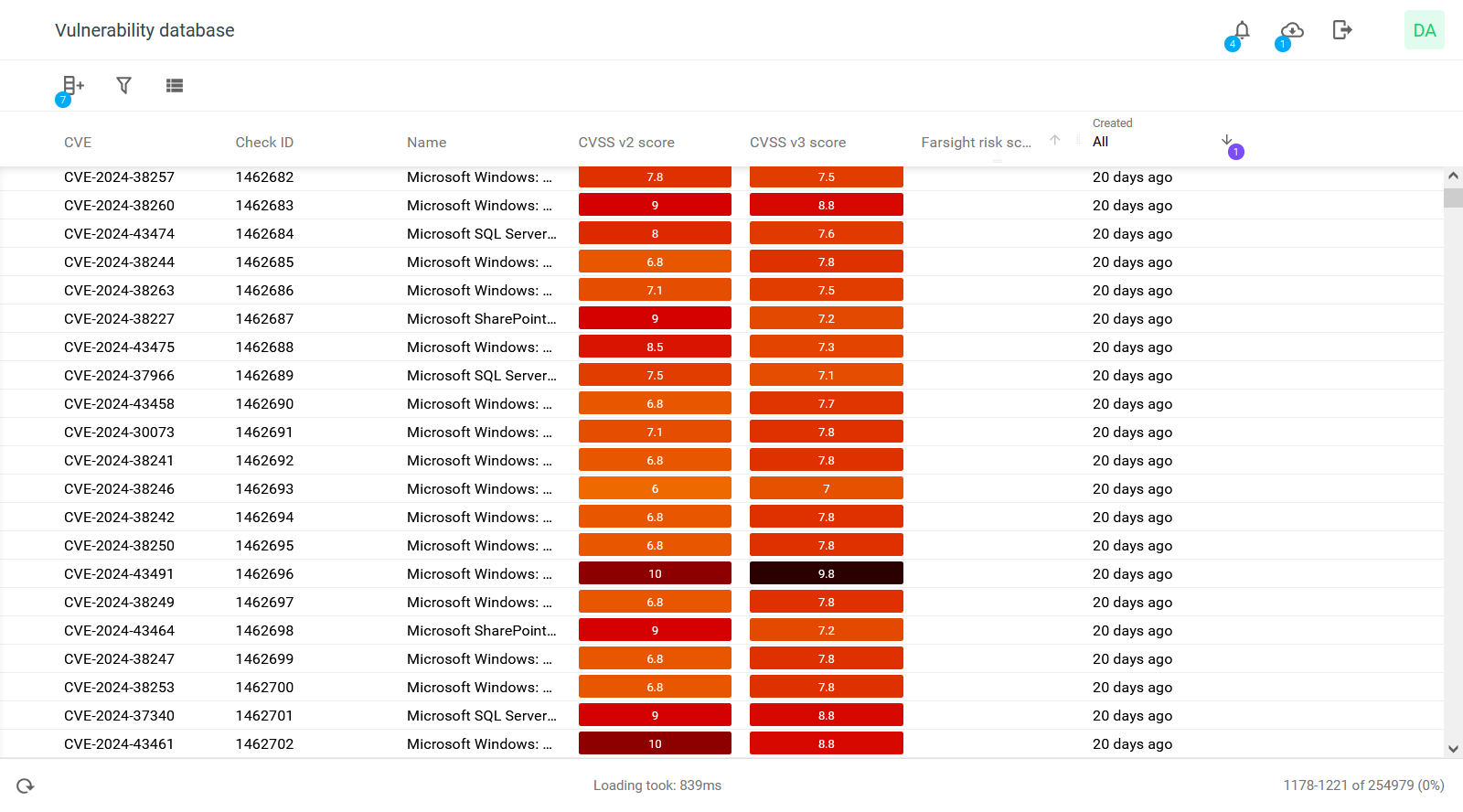
The Vulnerability Database table can be configured by using the Columns, Filter, and View template.
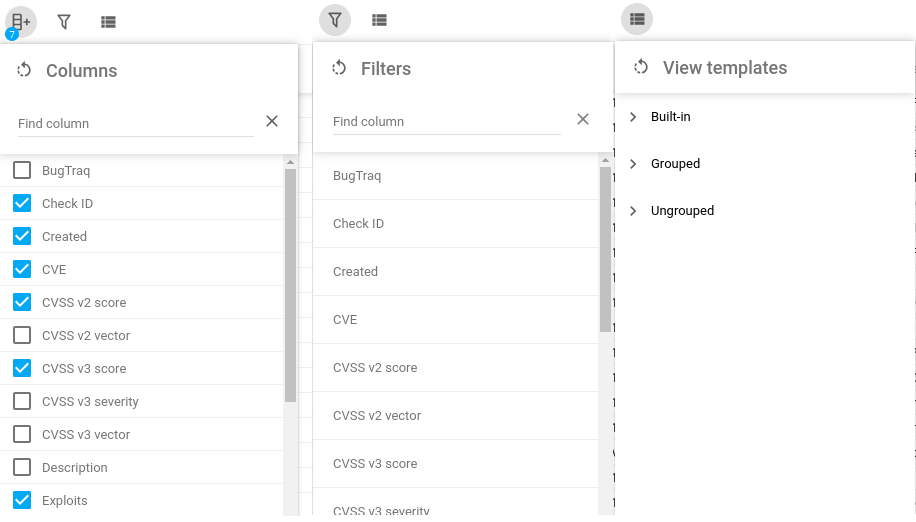
Selecting a vulnerability reveals more information about the vulnerability, such as Details, Exploits, and Comments.
Details Tab
The Details tab provides a complete risk profile by combining four critical data sets to drive effective remediation. It first establishes the vulnerability's Name, Description, and Solution alongside standard identifiers like CVE and CWE for the affected Asset. Crucially, it displays CVSS Scores for theoretical severity, countered by predictive Farsight and EPSS Scores which assess the real-world likelihood of exploitation. Finally, the tab incorporates Active Threat Intelligence, showing counts of related Exploits, Malware, and Campaigns to determine the immediate patching urgency.
 | 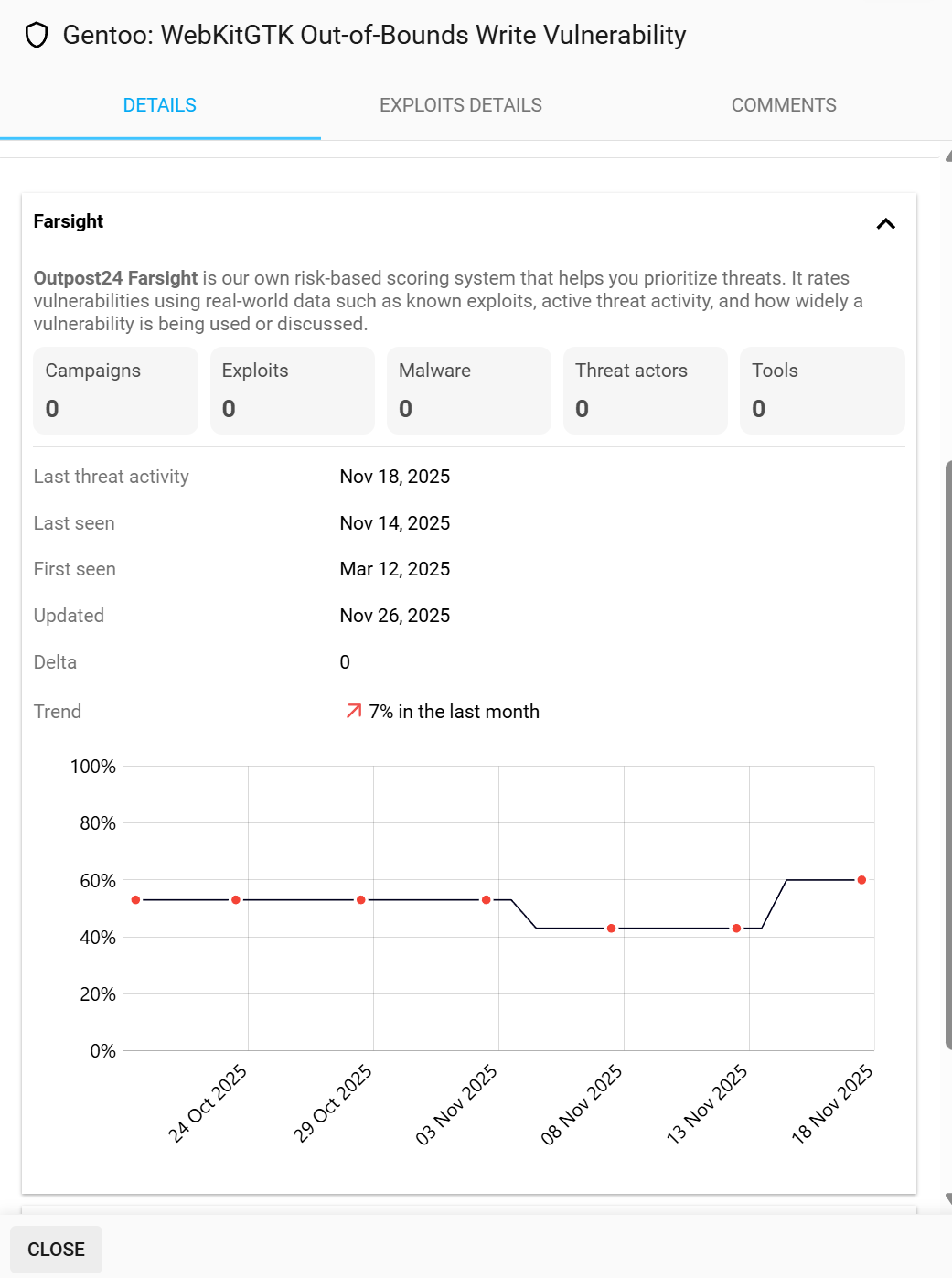 | 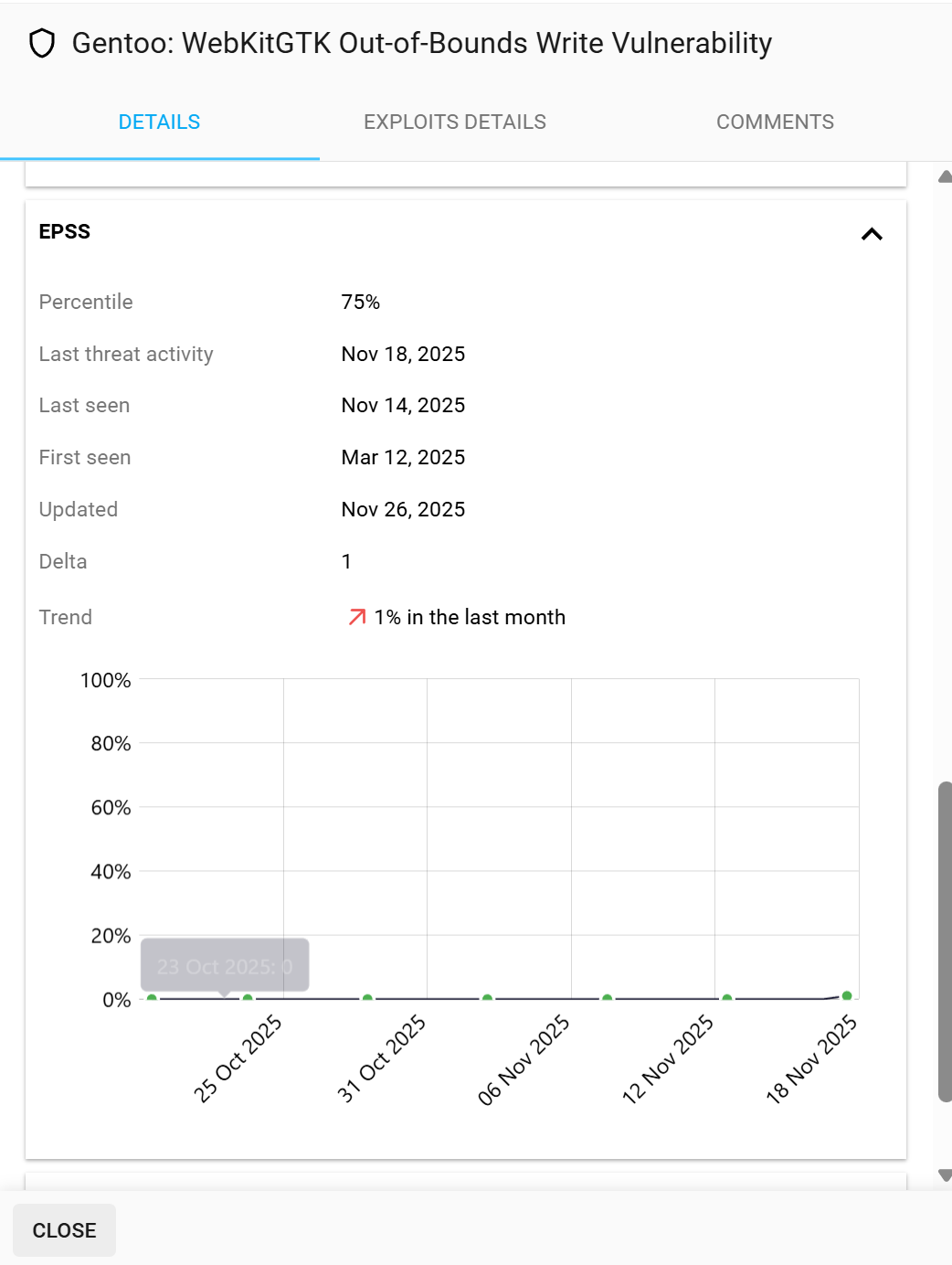 |  |
Option | Description |
Name | The official title or common name of the vulnerability (for example, "Microsoft Windows Server Remote Code Execution Vulnerability"). |
Description | A detailed text explanation of the vulnerability, the mechanism of the attack, and its potential impact on the system. |
Solution | A high-level summary of the recommended action to remediate the vulnerability. |
Last seen | The most recent date this vulnerability was successfully detected on the scanned asset. |
First seen | The earliest date this vulnerability was detected on the scanned asset. |
Updated | The last time this vulnerability record or its related threat intelligence was modified or refreshed in the database. |
Farsight | An internal, machine-learning-driven score representing the predicted Likelihood/Risk of exploitation, used for prioritization. |
Trend (Last Month) | A metric showing the change in the vulnerability's prevalence or activity over the last 30 days. |
Last threat activity | The most recent date when any threat intelligence (Exploit, Malware, etc.) related to this vulnerability was observed. |
CVSS v3 Score | The numerical severity rating based on the Common Vulnerability Scoring System, Version 3. |
CVSS v2 Score | The numerical severity rating based on the Common Vulnerability Scoring System, Version 2. |
Severity (Qualitative) | The descriptive risk level (Critical, High, Medium, Low) derived from the numerical CVSS score. |
CVSS v3/v2 Metrics | A list of all base vector parameters (e.g., Attack Vector, Confidentiality Impact) used to calculate the CVSS score. |
EPSS | The Exploit Prediction Scoring System score, indicating the probability of exploitation in the wild within 30 days. |
CVE | The unique identifier (Common Vulnerabilities and Exposures) for the vulnerability. |
CWE | The Common Weakness Enumeration ID, classifying the underlying programming flaw. |
CAPEC | The Common Attack Pattern Enumeration and Classification codes related to the exploit methods. |
OWASP Top 10 | A reference to the category within the OWASP Top 10 list of web application security risks. |
SANS Top 25 | The ranking or category reference within the SANS/CWE Top 25 Most Dangerous Software Errors. |
Campaigns | A count of known or active cyber attack campaigns leveraging this vulnerability. |
Exploits | A count of publicly available exploit code or proofs-of-concept for this vulnerability. |
Malware | A count of specific malware families known to use this vulnerability. |
Threat Actors | A count of recognized threat groups or actors targeting this vulnerability. |
Tools | A count of offensive security tools or scanners that include a module for this vulnerability. |
Exploits details Tab
The Exploits tab shows any known public exploits from various sources. It also shows the Farsight score – an easier way to address vulnerabilities that are relevant and may impact an organization irrespective of the CVSS score or the presence of an exploit for a vulnerability.
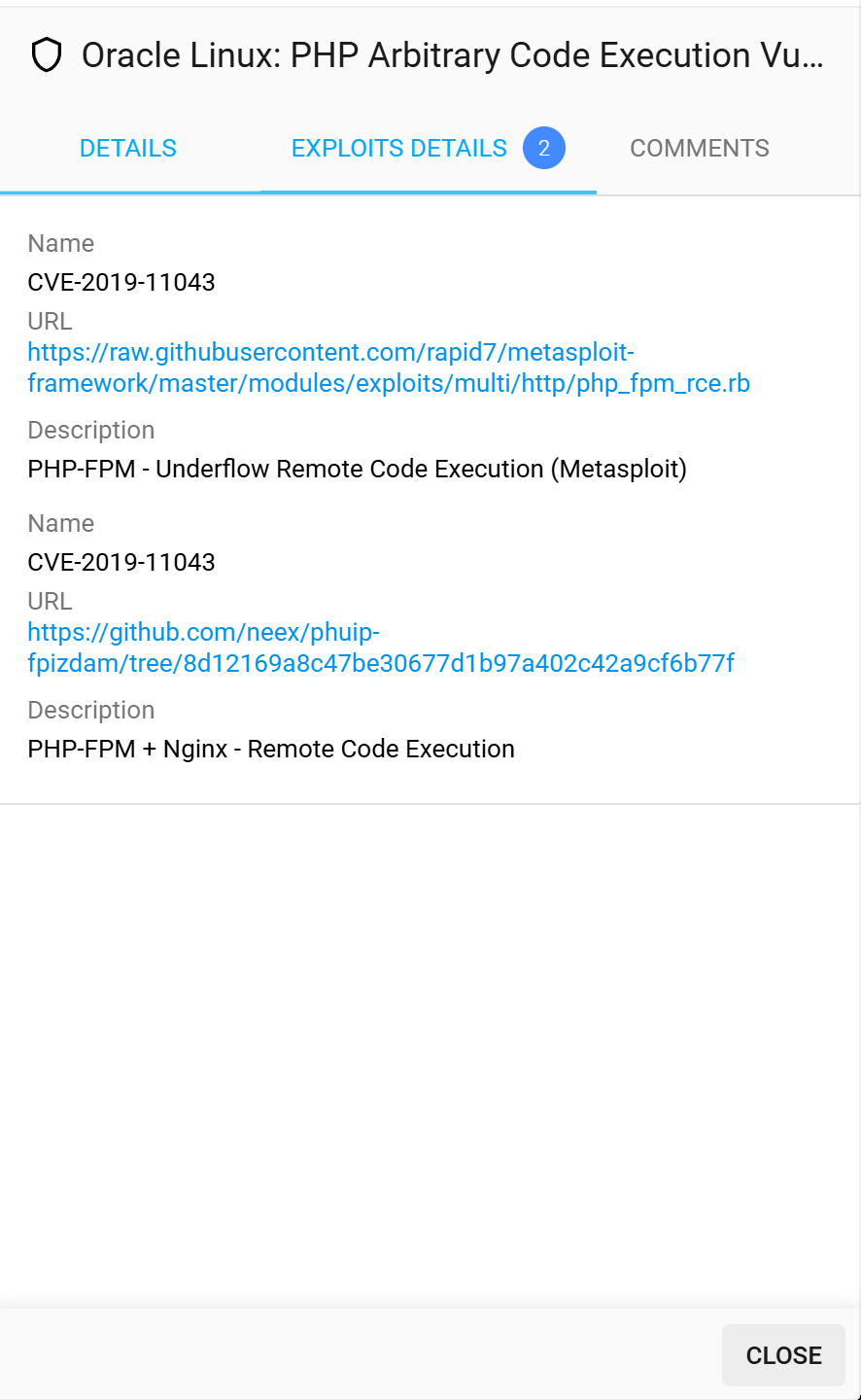
Option | Description |
|---|---|
Exploits | |
Name | The name of the CVE identifier which is an alphanumeric string that identifies a Publicly Disclosed vulnerability. |
Description | The description of vulnerability |
URL | A link to the vulnerability information at the source. |
Comments Tab
The Comments tab allows you to have internal discussions about the vulnerabilities. You can start discussions, reply to comments, and delete comments and discussions.
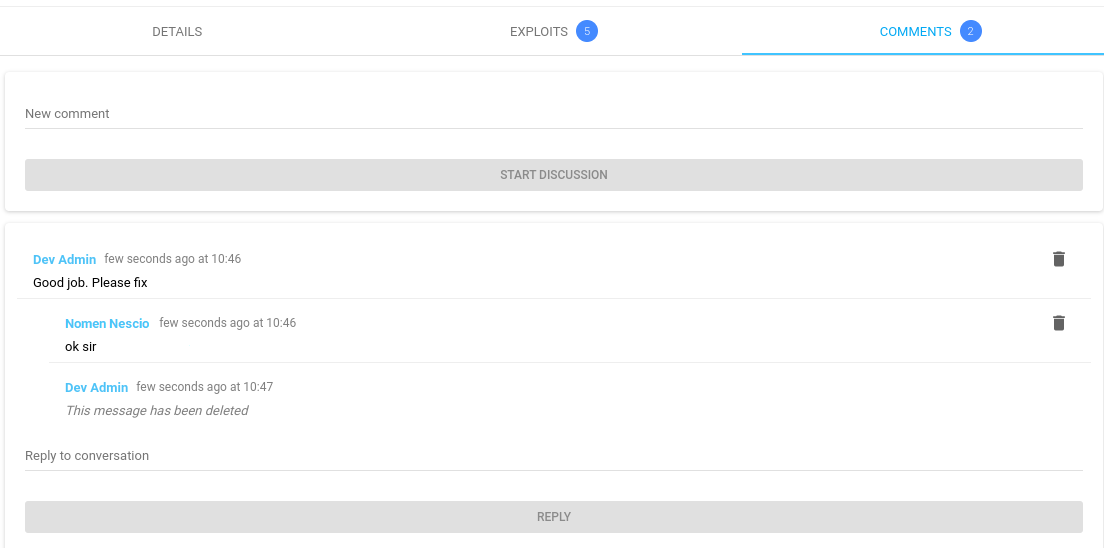
Comments Notification
Customers can manually set up an email/notification to notice when a new comment is created on a vulnerability.
1. Navigate to Configuration > Notification Settings in the Main Menu.
Click on the green plus
 button at the bottom right of the screen. A side tab will be opened for customers to create a new notification trigger.
button at the bottom right of the screen. A side tab will be opened for customers to create a new notification trigger.Enter a Name for the notification.
Set Trigger to Comment created.
Set Entity type to Check.
For Integration, there are two types: E-mail and Web notification.
Add the e-mail addresses to the users who will receive the notifications. This field is only available for the Email type of Integration.
Enter a Subject and Content. We support a Jinja2 template with a lot of variables and built-in functions.

Click the blue Add button in the lower right corner to save the Notification setting.
See Event Notifications for more information on Notifications and Notification Settings as well as templates and use cases.
After creating the configuration, the recipients receive a notification for every new comment on the vulnerabilities based on the trigger integration
type.
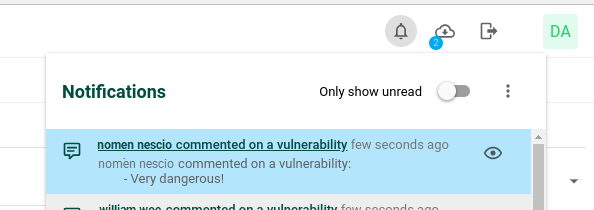

Reference
Related Articles
Copyright
© 2026 Outpost24® All rights reserved. This document may only be redistributed unedited and unaltered. This document may be cited and referenced only if clearly crediting Outpost24® and this document as the source. Any other reproduction and redistribution in print or electronically is strictly prohibited without explicit permission.
Trademark
Outpost24® and OUTSCAN™ are trademarks of Outpost24® and its affiliated companies. All other brand names, product names or trademarks belong to their respective owners.
